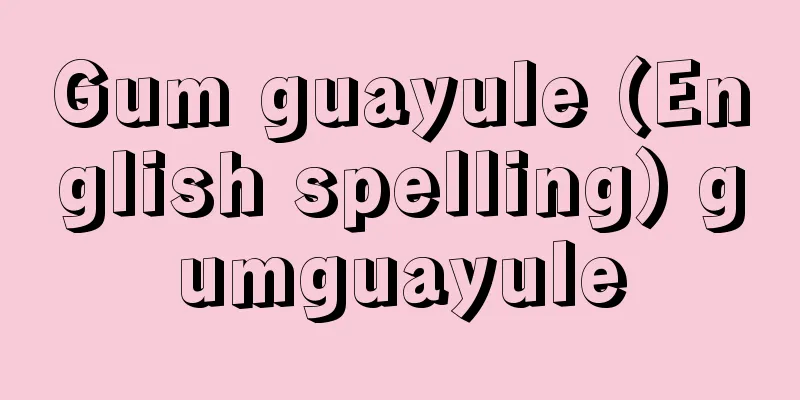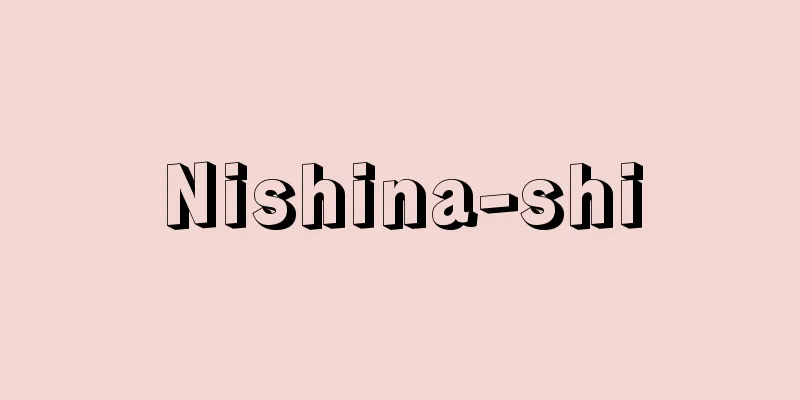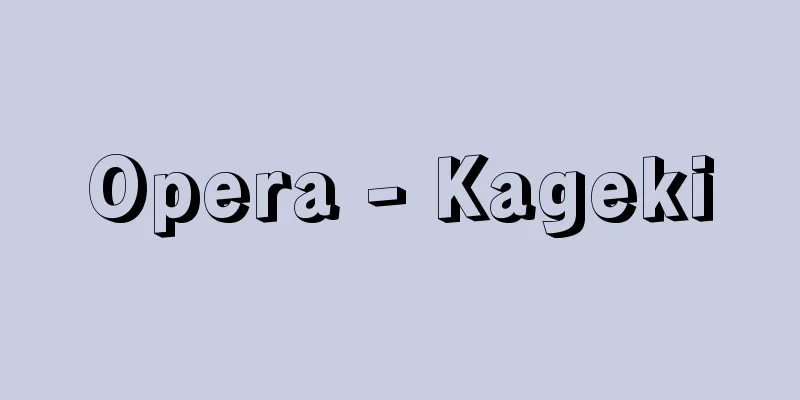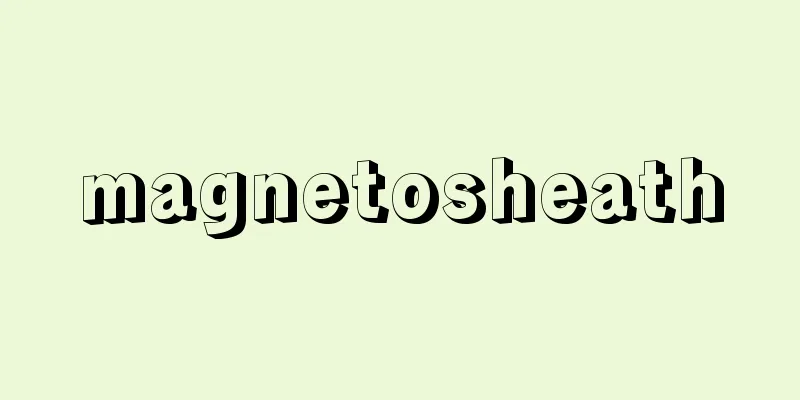Slovakia - Slovak Republic (English spelling)

|
A republic located in central Europe. It is a landlocked country surrounded by Ukraine to the east, Poland to the north, the Czech Republic and Austria to the west, and Hungary to the south. Its area is 49,035 square kilometers. Its population is 5,391,000 (UN estimate for 2006). Its capital is Bratislava. Together with the neighboring Czech Republic to the west, Slovakia constituted the federal state of Czechoslovakia, but the federation was dissolved and Slovak Republic became independent on January 1, 1993. It consists of 8 prefectures and 79 counties. The ethnic composition of the population is Slovaks (85.8%), Hungarians (9.7%), Roma (1.7%), Czechs (0.8%), and other minorities such as Ruscens and Ukrainians (2.0%). [Kimura Hideaki] Nature and GeographyMost of the country is covered by the Carpathian mountain range, and about 80% of it is located at high altitudes of over 750 meters above sea level. The gently sloping Lesser Carpathian and White Carpathian mountain ranges run in the northwest, while the steep Fatra and Tatra mountain ranges run from the center to the east. The Danube River Basin Plain stretches in the southwest, and the East Slovak Plain in the southeast. The highest point is 2,663 meters above sea level on Mount Gerlachovski, and the lowest point is 95 meters in the city of Streda Dona Vodrogom. The main rivers are the Danube, which forms the southwestern border, and the Bakh, Hron, Nitra, and Hornat, which run through the country from north to south. The climate is continental, with the lowest temperature nationwide in the coldest month of January being -10°C to -15°C, and the highest temperature in the warmest month of July exceeding 30°C. Important natural resources include magnesite, but other minerals include lignite, iron ore, antimony and mercury. Since the 1960s, industrialization has progressed rapidly, with the development of heavy industries such as petrochemicals, steel and machinery. However, after the collapse of the Comecon (Community for Economic Mutual Assistance) system as a result of political changes in Eastern European countries in 1989, profits in many industrial sectors that were not as competitive internationally have deteriorated, leading to an increase in unemployment (unemployment rate of 17.9% in 2000). On the other hand, commerce and service industries are steadily expanding in urban areas. Agriculture is centered on the southern plains, and in addition to wheat, barley, corn and other grains, sugar beets, potatoes, and fruits such as grapes and apricots are cultivated. Since independence, the environment surrounding agriculture has become increasingly harsh with the dissolution of collective farms and the reduction of government subsidies, forcing more efficient management. Forestry has traditionally been thriving in the central and eastern mountainous regions, and wood products are one of Slovakia's important exports. For more information, see the Czechoslovakia entry. [Kimura Hideaki] historyThe migration of Western Slavs to Slovakia is said to have occurred in the 5th and 6th centuries AD. They formed the Great Moravian state around 833. During this period, the brothers Cyril and Methodius attempted to introduce the Old Church Slavonic language. At the end of the 9th century, Hungarians began to invade the Great Danube Basin, and when Great Moravia collapsed in 906, the Slovak region was incorporated into the territory of the Kingdom of Hungary. As a result, the Western Slavs who lived in the region developed a unique ethnic identity as Slovaks. From around the end of the 15th century, Czech was used as a written language, and cultural ties with Bohemia were formed. After 1526, the territory of the Kingdom of Hungary, including the Slovak region, came under the control of the House of Habsburg. As part of the movement to form a nation-state that began at the end of the 18th century, a national awakening movement also occurred among Slovaks, and their own written language was established. During the 1848 Revolution, Slovak intellectuals, led by Sztul, participated in an expedition to oppose the Hungarian Revolution. Nationalist movements became more active in the 1860s, but after the establishment of the Austro-Hungarian Empire in 1867, Hungarianization policies were strengthened once again. After the outbreak of World War I, the idea of a common state with the Czechs emerged, and Slovak Štefánik joined Masaryk and others in the Czech independence movement. The Pittsburgh Accords of May 1918 promised autonomy for Slovaks in a common state. On October 28, the independence of the Czechoslovak state was declared in Prague, and on the 30th, a declaration in support of joining the state was adopted in Slovakia. The establishment of the Czechoslovak Republic greatly improved the political, social and cultural status of Slovaks, but since autonomy for Slovaks was not implemented, a movement for autonomy arose centered around the People's Party led by Hlinka. Following the Munich Agreement in September 1938, Hlinka's successor Tiso proclaimed the establishment of Slovakia on October 6, and on March 14, 1939, the Autonomous Assembly proclaimed Slovakia's independence. The independent Slovak state joined the Axis camp, and with the start of the German-Soviet War in June 1941, it sent troops to the Russian front. At the end of August 1944, an anti-fascist uprising broke out mainly in the central region, but was suppressed by the German army. In the spring of 1945, Slovakia was liberated by the Soviet army, and the Czechoslovak state was restored. After the Communist Party took power in February 1948, a strong socialist policy was implemented, and the state became more centralized. In the 1960s, the movement for federalization in Slovakia grew stronger, leading to the "Prague Spring" of 1968. After the Soviet military intervention in August of that year, the Federal Law was adopted in October, and the country moved to a federal system in January 1969. In April, a normalization regime headed by Husák was launched, and a period of political oppression and stagnation continued until the mid-1980s. In the second half of the 1980s, the movement of forces critical of the system became more active, and they played a key role in the rapid system change that began in November 1989. The first Mečiar cabinet, which was formed as a result of the election in June 1990, was replaced by the Czarnogurski cabinet in April 1991. The nationalists, led by Mečiar, who had been expelled from the government, organized the Democratic Slovakia Movement, which won a landslide victory in the June 1992 elections and formed the Second Mečiar Cabinet. Immediately after the election, moves to dissolve the federation surfaced, and the Slovak National Assembly passed a declaration of national sovereignty on July 17 and adopted a constitution on September 1. The federal system with the Czech Republic was peacefully dissolved, and the Slovak Republic was established on January 1, 1993. In March, Michal Kováč (1930-2016) became the first president, but political conflict with Prime Minister Mečiar became apparent, and in March 1994 the Moraučik Cabinet took over. However, in the September-October elections, the Democratic Slovak Movement (HZDS) won again, and the third Mečiar Cabinet was formed. The political situation became unstable, with conflict between President Kováč and Prime Minister Mečiar, and the kidnapping of the president's second son overseas in August 1995, and letters of opinion were sent from the EU (European Union) and the United States. When NATO (North Atlantic Treaty Organization) expanded eastward in July 1997, Slovakia was not allowed to join, but in 2004 it officially joined both NATO and the EU. In the 1998 parliamentary elections, HZDS remained the largest party, but was unable to form a coalition, and instead a coalition was formed with the center-right parties, including the Slovak Democratic Union (SDK), the Democratic Left Party (SDL), and the Hungarian Coalition Party (SMK), forming the Slinda Cabinet. In the 2002 elections, a coalition centered on the Slovak Democratic Christian Union, a reformed version of the SDK, also won a majority, and the second Slinda Cabinet was formed. However, in the 2006 elections, the center-left Smer (Direction Party) rose to become the largest party, forming a coalition with HZDS and the Slovak National Party (SNS), and forming a government headed by Smer's leader, Robert Fico (1964- ). [Susumu Nagayo] PoliticsConstitution and Political SystemThe Constitution of the Slovak Republic, adopted in September 1992, defines the country as a "sovereign democratic state governed by the rule of law." The basic spirit of the Constitution is succinctly expressed in the preamble, which reads, "We, the Slovak people, based on the natural right of national self-determination, strive to apply to the members of the national minorities and ethnic groups living on the territory of the Slovak Republic a democratic form of government, guarantees of a free life, spiritual and cultural development and economic prosperity." The Constitution is made up of 9 chapters and 156 articles, including: Chapter 1 - Basic Provisions, National Symbols and Capital; Chapter 2 - Fundamental Rights and Freedoms; Chapter 3 - Economy and the Supreme Audit Office; Chapter 4 - Local Self-Government; Chapter 5 - Legislative Power; Chapter 6 - Executive Power; Chapter 7 - Judicial Power; Chapter 8 - Public Prosecutor's Office; and Chapter 9 - Transitional and Final Provisions. [Susumu Nagayo] Legislative BodyThe only legislative body is the unicameral National Assembly of the Slovak Republic (150 seats), whose members are elected by direct suffrage for a four-year term. Voting is based on a list of candidates endorsed by each political party, and seats are allocated to each party according to the number of votes it receives, using a proportional representation system. To win a seat, a party must receive more than 5% of the total votes. As of 2008, the ruling coalition of Smer, SNS, and HZDS holds 85 seats, while the opposition, centered on SDKU and SMK, holds 65 seats. [Susumu Nagayo] presidentThe President is the head of state of the Slovak Republic and is elected by direct vote. He requires the support of more than three-fifths of the members of parliament (90 members), and serves a five-year term, with a maximum of two consecutive terms. The first President was Kováč, who took office in March 1993. Rudolf Schuster (1934- ) took office in 1999. Ivan Gašparovič (1941- ) took office in 2004 and was re-elected in 2009. [Susumu Nagayo] GovernmentThe Cabinet, the highest branch of the executive branch, is composed of the Prime Minister, Deputy Prime Ministers and Ministers. It is formed by the largest party in Parliament or a coalition of parties. The Prime Minister is appointed by the President (usually for a four-year term), and the other Ministers are appointed by the President on the Prime Minister's proposal. As of May 2009, Fico is the Prime Minister. Ministers are answerable to Parliament and resign when a new Parliament is elected. Since independence, Slovakia has had the following Cabinets: the Second Mečiar Cabinet (June 1992–March 1994), the Moraučik Cabinet (March–December 1994), the Third Mečiar Cabinet (December 1994–September 1998), the Žilinda Cabinet (October 1998–May 2006), and the Fico Cabinet (June 2006– ). [Susumu Nagayo] JudiciaryThe judicial branch consists of the Constitutional Court and ordinary courts. The Constitutional Court, located in Košice, is an independent institution that protects the constitutional system and reviews the constitutionality of the Constitution and laws, as well as decrees and regulations of the Cabinet, ministries, and local governments. The judges of the Constitutional Court (10 members) are appointed by the President on a proposal from the Parliament (7-year term). The ordinary courts consist of the Supreme Court and other courts. They deal with civil and criminal matters, and judges (4-year term) are selected by the Parliament on a proposal from the Cabinet. A jury system made up of citizens has also been introduced. [Susumu Nagayo] DiplomacyAfter gaining independence, the Slovak Republic rejoined the United Nations in January 1993. It smoothly established diplomatic relations with the United States, the European Union, and other countries, and also smoothly rejoined a series of international organizations, such as the General Agreement on Tariffs and Trade (GATT), the International Monetary Fund, and UNESCO. In June of the same year, it joined the Council of Europe, signed the Association Agreement on EU Membership in October, and joined the Partnership for Peace in February 1994. The government's foreign policy expressed a direction toward membership in the EU and NATO, while also placing importance on political and economic ties with Russia. The EU also repeatedly sent letters of opinion, stating that Slovakia's political situation and the current situation of its minorities did not meet the criteria necessary for EU membership. When NATO expanded eastward in July 1997, Slovakia's participation was postponed. However, it achieved full membership in both NATO and the EU in 2004. Furthermore, the EU's common currency, the euro, was introduced in January 2009. [Susumu Nagayo] defenseWith the dissolution of the Czechoslovak Federation, the Slovak Republic Armed Forces was born. The Slovak Armed Forces are composed of the Army and Air Force, with the President serving as the Supreme Commander of the Armed Forces. The army has 23,800 troops and the air force has 12,000 (1999). Conscription was in place (one year of mandatory military service), but it was abolished in 2004 and became a volunteer military service in 2005. [Susumu Nagayo] Economy and IndustryGDP (gross domestic product) began to recover in 1994, increasing by 4.9% from the previous year and 7.3% in 1995. Industrial production was at 62% of the 1990 level in 1993 due to the economic downturn caused by economic reforms, but gradually recovered and rose to 80% in 1995. For example, steel production was just under 4 million tons in 1995, returning to the level before the "economic reforms" adopted in 1990, before the dissolution of the federation with the Czech Republic. Agricultural production also declined, but is now recovering. The rate of increase in consumer prices has been on a downward trend, from a 13% increase from the previous year in 1994 to a 10% increase in 1995. The industrial structure is also gradually changing, with an increase in the number of people working in commerce and the service industry and a decrease in the number of people employed in mining and manufacturing. The privatization rate of state-run and public enterprises is increasing, and in 1995 private enterprises accounted for 60% of domestic production. The recovery in production is largely due to policies to protect domestic industry, but there are many issues that need to be improved in the future, such as the country's reliance on foreign sources of energy, the high proportion of raw materials in exports, and the slow pace of economic reform. Direct foreign investment up to 1995 was $700 million, less than one-eighth of that in the Czech Republic. The trade balance continued to be in the red, with exports of $7.9 billion and imports of $10 billion in 1995. Raw materials accounted for 41% of total exports, far ahead of machinery at 19%, while imports included machinery at 29%, fuel at 18% and raw materials at 18%. In terms of trading partners, the Czech Republic accounted for one-third of exports and imports each (1995), followed by Germany (around one-quarter of exports and imports), with other countries including Russia and Italy. Direct investment from Japan was low (five cases by 1995), and trade volumes from Japan in 1996 were $18 million in exports and $22 million in imports. [Taizo Nakamura] In 2008, GDP per capita was $17,630, economic growth rate was 6.4%, inflation rate was 3.94%, exports were 49.54 billion euros, and imports were 50.26 billion euros. Major export items were automobiles and parts, and major import items were electrical equipment and parts. Exports from Japan amounted to 48.2 billion yen, while imports were 22.4 billion yen. [Editorial Department] societyPeople and LanguageThe population is 5,379,455, with a male-female ratio of 48.6 to 51.4. The average life expectancy is 72 years (male: 68, female: 77). The natural population growth rate per 1,000 people is -0.2 and is declining. The population density is relatively low at 109.7 per square kilometer (2001). In terms of ethnic composition, Slovaks make up 85.8% of the population. Hungarians (9.7%) are an ethnic minority group and live in the southern border region with Hungary. The next largest group are Roma (formerly known as Gypsies), who are scattered throughout the country, mainly in the eastern region. The official figure is 89,920 (1.7%), but the actual number is thought to be higher. In addition, Czechs (0.8%) and Moravians live mainly in the capital Bratislava and in the western region, while Ruscens (an East Slavic ethnic group close to Ukrainians) and Ukrainians live in the mountainous border region of the northeast. There are also small numbers of Germans, Poles, Russians, and others. Slovak is the native language of Slovakians, a West Slavic language. It is closely related to Czech, and speakers of both languages can understand each other without any problems. The constitution stipulates that Slovak is the national language, and in 1995 the National Language Act was passed giving Slovak a priority status. Other minority languages, such as Hungarian, Czech, Rusinian, and Ukrainian, are also spoken, and the constitution guarantees the use of these languages in publishing, education, and in official spheres. [Susumu Nagayo] National LifeTraditionally, Slovakia was a rural society, but after the Second World War, the social structure modernized, and in the 1960s the ratio of people working in agriculture to those working in other industries reversed. This resulted in a migration of the population from rural areas to cities, and 57% of the total population now lives in cities. The country is divided into 2,867 municipalities, of which 136 are cities (1997). The major cities include the capital, Bratislava (population 428,672 in 2001), the center of the eastern region, Košice (population 236,093 in 2001), Prešov, Nitra, Žilina, Banská Bystrica, Trnava, Martin, Trenčín, Poprad, and Prieviza. In 1996 a new system of local government was introduced and the country was redivided into 8 provinces (Bratislava, Trnava, Trenčín, Nitra, Žilina, Banská Bystrica, Prešov and Košice) - 79 counties. Since the end of 1989, the Slovak society has been undergoing fundamental changes. While positive changes such as the general liberalization of social life and the establishment of a democratic multi-party system have been brought about, negative phenomena such as the rise in living expenses and prices due to the transition to a market economy, and the rise in unemployment (unemployment rate was 17.9% in 2000), have also become evident, and many people feel that their standard of living has declined. The average monthly income is 7,000 Slovak koruna (approximately 25,000 yen in 1995). The rise in the crime rate (which has doubled in the five years since 1993) is also one of the factors that is increasing social unrest. In particular, the sharpening of discrimination against the Roma minority is a serious social problem. Environmental problems such as air pollution and pollution remain serious, and the huge Danube River irrigation facility built in Gapcikovo in the southern region is a major issue of dispute with Hungary. However, despite all these problems, the process of social liberalization and transition to a market economy is revitalizing Slovak society and appears to be irreversible. [Susumu Nagayo] educationThe education system consists of preschool education in kindergarten, compulsory primary education (basic school), secondary education (gymnasium, secondary vocational school, vocational technical school, progression rate of about 43%), and higher education (university and college). Since 1990, church-run and private schools have been allowed to be established. Educational facilities in Hungarian and Ukrainian are also available up to the secondary education level for minorities. There are 14 universities in the country (1995). In addition to Komenski University in Bratislava and P. J. Šafárik University in Košice, there are also technical universities, economics universities, music universities, and plastic art universities in Bratislava, technical universities and veterinary universities in Košice, transport universities in Žilina, agricultural universities in Nitra, and forestry universities in Zvolen. The total number of students is 74,000 (1995). [Susumu Nagayo] Mass MediaWith the systemic change since 1989, ideological restrictions on the mass media were removed, censorship was abolished, and freedom of speech and publication was guaranteed. Previously state-run publishing companies were privatized, and at the same time, many privately-run publishing companies were born, and the publishing world is booming. In 1995, the total number of newspapers and magazines published was 1,017, more than three times the number in 1989. However, there are also phenomena such as a decrease in high-quality publications due to cuts in state subsidies and the prevalence of popular publications. There are 20 daily newspapers published (1995). The most widely read include the popular Nový Čas (New Era), the left-wing Pravda (Truth), the former trade union paper Placa (Labor), the neutral Národná obroda (National Renewal), the liberal Zme, and the ruling party's press release Slovenska Republika (Slovak Republic). Popular weeklies include the graphic magazine Život (Life) for the general household and the graphic magazine Slovenka (Slovak Woman) for women. In addition to the state-run Slovakia First radio station, there are private broadcasting stations such as Radio Twist and Rock FM Radio. Television is provided by the two state-run channels STV1 and STV2, as well as the private broadcasting station Markiza, which began broadcasting in 1996. In areas close to the border, broadcasts from the Czech Republic, Austria, Hungary and other countries can also be received, and satellite broadcasting is widely available in most homes. [Susumu Nagayo] religionUnder the socialist system, the free social activities of churches were restricted, but Christian faith took deep root among the residents. After the change of system at the end of 1989, each denomination was freed from the constraints of the state and regained social influence. According to the 2001 census, the largest religious force in Slovakia is the Roman Catholic Church, with believers accounting for 68.9% of the population. In addition, the Protestant Lutheran (Evangelical) Church (6.9%) and the Reformed (Calvinist) Church (2.0%) have traditionally maintained a certain degree of influence, and in the eastern region, where many Russians and Ukrainians live, the Greek Catholic Church (Eastern Church), a denomination of the Orthodox Church that follows the Roman Catholic Church, and the Eastern Orthodox Church have a strong base (4.1%). The Jewish faith, which was quite prevalent before World War II, has become a minority. In addition, about 13% of the population answered that they have no faith. [Susumu Nagayo] welfareThere are 14,081 medical facilities (1995), including 5,417 hospitals, throughout the country. The total number of doctors is 14,447, which means that there is one doctor for every 371 people. The increasing burden of medical insurance under the new market economy and the chronic shortage of doctors and nurses have become serious social issues. Piestany, Trencianske Čeplice, Sliac, and Baržejo have long been known as therapeutic hot springs, with approximately 130,000 visitors a year (1995). [Susumu Nagayo] cultureOverviewAt the end of the 18th century, the national enlightener Anton Bernolák (1762-1813) established a written language based on the western dialect, laying the foundations for the creation of modern Slovak literature in the national language. In 1843, the national enlightener Štul established a written language based on the more widely circulated central dialect, thus establishing the norms of the modern standard language. A group of romantic writers, including Samo Chalupka (1812-1883), Andrej Sládkovič (1820-1872), Ján Kalinčiak (1822-1871) and Janko Král' (1822-1876), actively used this written language for their writing. In the second half of the 19th century, a generation of realists, represented by the poet Hvězdoslav and the writer Martin Kukučín (1860-1928), emerged, and in the early 20th century, new literary trends were formed, including the critical realist Janko Jesenský (1874-1945) and the modernist Ivan Krasko (1876-1958). In the period between the First and Second World Wars, the naturalist writers Jozef Cíger Hronský (1896-1960) and František Švantner (1912-1950), the proletarian writer Ladislav Novomeský (1904-1976), and the Catholic modernist Rudolf Dilong (1905-1986) were active. For a time after the Second World War, there were attempts to introduce socialist realism, but from the second half of the 1950s onwards, writers such as Dominik Tatarka (1913-1989), Mniacko and Alfonz Bednár (1914-1989) began to produce works that critically portrayed the social situation under the socialist regime. Since 1969, literary activity has stagnated due to the strengthening of ideological restrictions, but a group of unique writers such as Johanides and Rudolf Sloboda (1938-1995) have emerged. After the change of regime at the end of 1989, Slovak writers were freed from political constraints. [Susumu Nagayo] Cultural FacilitiesThere are 3,256 libraries in the country (1995), among which the University Library and Technical Library in Bratislava and the Ethnographic Library of the ethnic cultural organization Macica Slovenska based in Martin boast rich collections. There are 60 museums in the country, with the Ethnographic Museum in Bratislava (archaeology, history, natural sciences), the City Museum (pharmacy, watches, wine, etc.), and the Rural Museum in Martin being particularly well-known. There are 18 art museums throughout the country, the most representative of which is the Ethnographic Museum in Bratislava, founded in 1948. A unique museum commemorating Andy Warhol has opened in Medziraborce in the eastern region. There are 37 permanent theaters throughout the country, where a total of about 5,000 performances are held each year, attracting 1.4 million visitors. Bratislava is home to the Folk Theatre, the Small Theatre (Mala szena), the New Theatre (Nová szena), the National Puppet Theatre and the acclaimed amateur theatre company Radšin Naib. [Susumu Nagayo] movieThe first Slovak film, Jánosík (1921), was made with the help of Slovaks who had emigrated to the United States. This silent film was based on the life of a famous Slovak bandit. After the Second World War, full-scale film production began, and a series of works by Pal'o Bielik (1910-1983), which covered the 1944 national uprising, were also shown in Japan. In the 1960s, a group of talented directors, including Štefan Uher (1930-1993), Juraj Jakubisko (1938- ), and Dušan Hanák (1938- ), made their debut. Hanák's film A Hundred Years' Dream (1972), which premiered 16 years later, received high praise both at home and abroad. The change of system in 1989 also freed the film industry from ideological constraints. Financial difficulties following cuts in state subsidies have become a major problem, leading to a decline in the number of productions, but there have still been some excellent works produced, such as Martin Šulík's (1962- ) The Garden (1995) and Hanák's Paperheads (1996). [Susumu Nagayo] Relations with JapanPeople in Central Europe, including Slovakia, probably learned of the existence of Japan through Marco Polo's Travels (1298). From the mid-16th century onwards, detailed information about Japan was made available through the missionary activities of the Catholic Church in East Asia. M. Beniowski, who stopped off the coast of Japan on his way back to Europe from his exile in Kamchatka in 1771 (Meiwa 8), had a major impact on Japan's anti-Russian attitude. He is said to be Hungarian, but he was born in what is now Slovakia. Chinoiserie (orientalism), which was popular in Europe in the 17th and 18th centuries, also influenced the culture of Central Europe. The epic poem Daughter of Slava (1832) by Kolar, a representative poet of the Czech and Slovak national revival movement, contains exotic poems on themes of China and Japan. It was after the Meiji Restoration that Central Europe, including Slovakia, began to emerge in the minds of Japanese people. In 1869 (Meiji 2), Japan and Austria-Hungary, to which Slovaks belonged at the time, concluded a Treaty of Amity, Commerce and Navigation. The World's Fair held in Vienna in 1873 was an opportunity to broaden Japan's understanding of Central Europe. The Report of the Macau Exposition (1875) even mentions Slovaks. In May 1918, at the end of World War I, when the Czechoslovak legions occurred in Russia, the Japanese government declared its Siberian military service in August of the same year, using the legions as an excuse to support the legions, and in September approved the Czechoslovak National Conference. In connection with this situation, Slovak independence activist M.R. Schefanik stayed in Japan as a member of the French military mission from October to November, appealing to the government, military and media about Czechoslovak independence and the existence of the legions. The legions and Japanese forces made contact in the Siberian Far East region, and between 1919 and 1920, approximately 67,000 legions soldiers returned to Japan. These incidents made Czechoslovakia widely known in Japan, and knowledge about Japan spread throughout the world through the observations of the legions soldiers who were in the days of their lives. For example, in his experiences in his experiences, "On the Road to Freedom" (1933), author Yessenky wrote about his experiences living in Japan. Japan recognized the country immediately after Czechoslovakia independence in October 1918, and relatively active cultural exchanges took place between the two countries throughout the interwar periods of World War I and the two countries. When Czechoslovakia dismantled in March 1939 and an independent Slovak nation was established, Japan recognized the country in June of the same year. During World War II, the two countries were allies belonging to the same Axis camp, and when Japan declared war on the US and Britain in December 1941, the independent Slovak nation also declared war with the two countries. In 1957 after World War II, diplomatic relations between Japan and Czechoslovakia were restored, and as a result, mutual exchanges resumed in the fields of culture and economics. Works by Munyachiko and Bednar were translated into Japanese from Slovak literature, and several works of Japanese literature were also translated into Slovak. When the Slovak Republic was independence in January 1993, Japan recognized the country on the same day and established diplomatic relations in February. Prime Minister Gilinda visited Japan in 2005. [Nagayo Susumu] になったんです。 English: The first thing you can do is to find the best one to do . "World History and Culture, Central Europe, Poland, Czech Republic, Slovak, Hungary, Supervised by Numano Mitsuyoshi" (1996, Shinchosha)" ▽ "Momose Hiroshi et al., "The Basic Series 5 of International Situations, Eastern Europe" 2nd Edition (2001, Jiyukunisha)" [References] | | | | Stuhl | | | | | | | | | | | | | | | [Complementary Materials] |"> Slovakia flag ©Shogakukan Illustration/Shogakukan Creative "> Slovakia location map Source: Shogakukan Encyclopedia Nipponica About Encyclopedia Nipponica Information | Legend |
|
ヨーロッパ中央部に位置する共和国。東部をウクライナ、北部をポーランド、西部をチェコとオーストリア、南部をハンガリーに囲まれた内陸国である。面積4万9035平方キロメートル。人口539万1000(2006国連推計値)。首都ブラチスラバ。 西に隣接するチェコとともに連邦国家チェコスロバキアを構成していたが、連邦を解消し、1993年1月1日にスロバキア共和国として独立した。8県79郡からなる。住民の民族構成はスロバキア人が全体の85.8%を占め、9.7%のハンガリー人のほかにロマ1.7%、チェコ人0.8%、ルシーン人、ウクライナ人などその他の少数民族が2.0%となっている。 [木村英明] 自然・地誌国土の大部分はカルパティア山系の山々に覆われ、約80%が標高750メートル以上の高地に位置している。北西部にはなだらかな小カルパティア、白カルパティア、中央部から東部にかけては峻険(しゅんけん)なファトラ、タトラの各山脈が走る。南西部にドナウ川流域平野、南東部に東スロバキア平野が広がる。標高最高地点はゲルラホウスキー山の2663メートル、最低地点はストレーダ・ドナ・ボドロゴム市の95メートルである。主要河川は南西部の国境を形成するドナウ、国土を北から南に貫通するバーフ、フロン、ニトラ、ホルナートなど。気候は大陸性で、全国的に最寒月1月の最低気温は零下10℃~零下15℃、最暖月7月の最高気温は30℃を上回る。重要な天然資源にマグネサイトがあり、ほかに褐炭、鉄鉱石、アンチモニーや水銀などを産出する。 1960年代以降、工業化が急速に進み、石油化学、製鉄や機械などの重工業が発展した。しかし、1989年に起こった東欧各国の政治変動の結果、コメコン(経済相互援助会議)体制が崩壊してからは、国際競争に劣る多くの工業部門で収益が悪化し、失業者増加の原因となった(2000年の失業率17.9%)。一方では、商業、サービス業が都市部で着実に規模を広げつつある。農業は南部の平野を中心に小麦、大麦、トウモロコシほかの穀物に加え、テンサイやジャガイモ、さらにブドウやアプリコットなど果物も栽培されている。独立以降、集団農場の解体、政府補助金の削減と農業を取り巻く環境は厳しさを増し、より効率的な経営を迫られている。中部、東部山岳地帯では林業が伝統的に盛んで、木材加工品はスロバキアの重要な輸出品の一つになっている。そのほか「チェコスロバキア」の項も参照されたい。 [木村英明] 歴史スロバキア地域への西スラブ人の移住は紀元5~6世紀とされる。彼らは833年ころ、大モラビア国を形成した。この時期キュリロスとメトディオス兄弟により古代教会スラブ語の導入が図られた。9世紀末ハンガリー人の大ドナウ盆地侵入が始まり、906年大モラビア国が崩壊すると、スロバキア地域はハンガリー王国の版図に組み込まれた。このために同地域に住んでいた西スラブ人は、スロバキア人として固有の民族性を形成した。15世紀末ごろからチェコ語が文章語として用いられ、ボヘミアとの文化的結び付きが生じた。1526年以降スロバキア地域を含むハンガリー王国の領土は、ハプスブルク家の支配下に置かれた。18世紀末に開始された国民国家形成の動きのなかで、スロバキア人の間でも民族覚醒(かくせい)運動が起こり、独自の文章語が制定された。1848年革命期にシトゥールを中心としたスロバキアの知識人は、ハンガリー革命に対抗する遠征に参加した。1860年代に民族運動が活性化したが、1867年のオーストリア・ハンガリー二重帝国成立以降、ふたたびハンガリー化政策が強化された。第一次世界大戦勃発(ぼっぱつ)後、チェコ人との共同国家構想が浮上し、スロバキア人シチェファーニクはマサリクらのチェコ人独立運動に参加した。1918年5月ピッツバーグ協定は、共同国家でのスロバキア人の自治を約束した。10月28日プラハでチェコスロバキア国家独立が宣言され、30日にはスロバキアでも同国家加盟を支持する宣言が採択された。 チェコスロバキア共和国の成立によって、スロバキア人の政治的、社会的、文化的地位は大きく向上したが、スロバキア人の自治が実施されなかったために、フリンカの率いる人民党を中心に自治要求運動が起こった。1938年9月ミュンヘン協定を契機に、フリンカの後継者ティソは10月6日スロバキア成立を宣言し、1939年3月14日自治議会はスロバキア独立を宣言した。独立スロバキア国は枢軸陣営に参加し、1941年6月独ソ戦開始とともにロシア戦線に軍隊を派遣した。1944年8月末、中部地域を中心に反ファシズム蜂起(ほうき)が勃発したが、ドイツ軍によって鎮圧された。1945年春、スロバキアはソ連軍によって解放され、チェコスロバキア国家が復興された。1948年2月共産党の権力掌握後、強硬な社会主義化政策が実施され、国家は中央集権的性格を強めた。1960年代スロバキアで連邦化を求める動きが強まり、1968年の「プラハの春」につながった。同年8月ソ連軍の軍事介入後、10月に連邦法が採択され、1969年1月から連邦体制に移行した。4月フサークを頭とする正常化体制が発足し、政治的締付けと沈滞の時期は1980年代なかばまで続いた。1980年代後半になって体制批判勢力の動きが活発化し、1989年11月に始まる急激な体制転換を担った。1990年6月選挙の結果成立した第一次メチアル内閣は、1991年4月チャルノグルスキー内閣に交代した。政権から排除されたメチアルを中心とするナショナル派は、民主スロバキア運動を組織し、1992年6月選挙で大勝して第二次メチアル内閣が組閣された。選挙直後から連邦解体の動きが表面化し、スロバキア国民議会は7月17日に国家主権宣言を可決、9月1日に憲法を採択した。 チェコとの連邦体制は平和裏に解体して、1993年1月1日スロバキア共和国が成立した。3月コバーチMichal Kováč(1930―2016)が初代大統領に就任したが、首相メチアルとの政治対立が顕在化し、1994年3月モラウチーク内閣にかわった。しかし9~10月選挙でふたたび民主スロバキア運動(HZDS)が勝利し、第三次メチアル内閣が成立した。大統領コバーチと首相メチアルの対立、1995年8月の大統領次男国外誘拐事件など、不安定な政局が目だつようになり、EU(ヨーロッパ連合)とアメリカから意見書が送られた。1997年7月のNATO(ナトー)(北大西洋条約機構)東方拡大の際は、スロバキアの参加は見送られたが、2004年にNATO、EUともに正式に加盟している。 1998年の国民議会選挙では、HZDSは第一党を維持したものの、連立を組むことができず、スロバキア民主連合(SDK)が中心となり、民主左翼党(SDL)、ハンガリー人連立党(SMK)などの中道右派による連立が成立、スリンダ内閣を樹立した。2002年の選挙でもSDKを改編したスロバキア民主キリスト教連合を中心とした連立が過半数を占め、第二次スリンダ内閣が発足した。しかし、2006年の選挙では、中道左派のスメル(Smer、方向党)が第一党に躍進、HZDSおよびスロバキア国民党(SNS)と連立を組み、スメル党首のフィツォRobert Fico(1964― )を首班とする政権を成立させた。 [長與 進] 政治憲法・政治体制1992年9月に採択されたスロバキア共和国憲法は、同国を「主権を有する民主主義的な法治国家」と規定している。憲法の基本精神は、「われわれスロバキア民族は、民族自決の自然権に立脚しつつ、スロバキア共和国の領土に居住する少数民族と民族グループの構成員たちとともに、民主主義的な統治形態、自由な生活の保障、精神文化の発展と経済的繁栄を適用すべく努める」という前文の一節に、端的に表現されている。本文は9編156条から構成され、第1編―基本規定・国家シンボル・首都、第2編―基本的権利と自由、第3編―経済と最高監査庁、第4編―地方自治、第5編―立法権、第6編―行政権、第7編―司法権、第8編―検事局、第9編―経過規定と最終規定という内容である。 [長與 進] 立法機関唯一の立法機関は、一院制のスロバキア共和国国民議会(定数150議席)で、議員は直接選挙によって選出され、任期は4年である。投票は政党別の公認候補者名簿によって行われ、各党の得票数に従って議席が割り当てられる比例代表制である。議席獲得のためには、投票総数の5%を超える必要がある。2008年現在の議席配分は、スメル、SNS、HZDSの連立政権与党が85議席、SDKU、SMKを中心とする野党65議席となっている。 [長與 進] 大統領大統領はスロバキア共和国の国家元首で、直接選挙によって選出する。議員の5分の3(90名)以上の支持が必要で、任期は5年、連続2期を最大限とする。初代大統領は、1993年3月に就任したコバーチである。1999年にはシュステルRudolf Schuster(1934― )が就任。2004年ガシュパロビッチIvan Gašparovič(1941― )が就任、2009年に再選された。 [長與 進] 行政行政の最高機関である内閣は、首相、副首相、各大臣から構成され、議会の第一党か、諸政党の連立によって組閣される。首相は大統領が任命し(通常の任期は4年)、その他の閣僚は、首相の提案に基づいて大統領が任命する。2009年5月現在の首相はフィツォである。閣僚は議会に対して責任を負い、選挙によって新たな議会が選出されたときに辞職する。独立後のスロバキアの歴代内閣は、第二次メチアル内閣(1992年6月~1994年3月)、モラウチーク内閣(1994年3月~12月)、第三次メチアル内閣(1994年12月~1998年9月)、ジリンダ内閣(1998年10月~2006年5月)、フィツォ内閣(2006年6月~ )である。 [長與 進] 司法司法機関は、憲法裁判所と通常の裁判所から構成される。コシツェに置かれた憲法裁判所は、立憲制度を保護するための独立した機関で、憲法や法律の合憲性や、内閣・各省・地方自治体の政令や法規などを再審議する。憲法裁判所の裁判官(10名)は、議会の提案に基づいて大統領が任命する(任期7年)。通常の裁判所は、最高裁判所とそのほかの裁判所から構成される。民事問題と刑事問題を処理することを目的とし、裁判官(任期4年)は内閣の提案に基づいて議会が選出する。市民から構成される陪審員制度も導入されている。 [長與 進] 外交スロバキア共和国は独立後の1993年1月改めて国際連合に加盟した。アメリカやEU(ヨーロッパ連合)諸国をはじめとする諸外国との外交関係の樹立はスムーズに行われ、GATT(ガット)(関税貿易一般協定、1995年以降はWTO(世界貿易機関))、IMF(国際通貨基金)、ユネスコなど一連の国際機構への再加盟も順調に実現した。同年6月にヨーロッパ会議に加盟し、10月にはEU加盟に関する連合(準加盟)協定に調印、1994年2月には「平和のためのパートナーシップ」にも参加した。政府の外交方針は、EUとNATO(ナトー)(北大西洋条約機構)加盟の方向性を表明しつつ、ロシアとの政治的、経済的結び付きも重視した。EU側も、スロバキアの政治状況やマイノリティ(少数民族)の置かれた現状が、EU加盟に必要な基準を満たしていないとして、繰り返し意見書を送った。1997年7月のNATOの東方拡大の際は、スロバキアの参加は見送られた。しかし2004年にはNATO、EUともに正式加盟が実現している。さらに、2009年1月からはEUの共通通貨ユーロが導入された。 [長與 進] 防衛チェコスロバキア連邦解体によって、独自のスロバキア共和国軍が誕生した。スロバキア軍は陸軍と空軍から構成され、大統領が軍の最高司令官を兼任している。保有兵力は、陸軍2万3800、空軍1万2000(1999)である。徴兵制(兵役義務は1年)が敷かれていたが、2004年に徴兵制は廃止され、2005年から志願兵制となった。 [長與 進] 経済・産業GDP(国内総生産)は1994年より回復し始め、前年の4.9%増、1995年7.3%増であった。鉱工業生産は、1993年には経済改革による経済の落込みから1990年の62%の水準であったが、徐々に回復し、1995年80%に上昇した。たとえば、鉄鋼生産は1995年400万トン弱と、チェコとの連邦解体前の1990年に採択された「経済改革」前の水準に戻った。また、農業生産も低下したが、回復しつつある。 消費者物価の上昇率は1994年に前年比13%増から1995年10%増と縮小傾向にある。 産業構造も徐々に変化していて、商業やサービス業の従事者が増大し、鉱工業就業者が減少傾向にある。国営、公営企業の民営化率は増大しつつあり、1995年に国内生産の60%を私企業が占めるようになった。生産の回復は国内産業保護政策によるところが大であるが、エネルギー源の供給を外国に依存する体質や輸出に占める原材料比率の高さ、経済改革テンポの遅れなど今後改善すべき課題が多い。1995年までの外国からの直接投資は7億ドルで、チェコの8分の1弱と少ない。 貿易収支は赤字が続き、1995年の輸出は79億ドル、輸入100億ドルであった。輸出は原材料が全体の41%と機械の19%をはるかに引き離し、輸入は機械29%、燃料18%、原材料18%などであった。取引相手国はチェコが輸出入のそれぞれ3分の1(1995)を占め、次にドイツ(輸出入の4分の1前後)が続き、ほかはロシア、イタリアなどである。日本からの直接投資は少なく(1995年までに5件)、貿易額も1996年に日本からの輸出1800万ドル、輸入2200万ドルであった。 [中村泰三] 2008年では、1人当りのGDPは1万7630ドル、経済成長率は6.4%、物価上昇率は3.94%、輸出は495億4000万ユーロ、輸入は502億6000万ユーロとなっている。輸出品目は自動車と部品、輸入品目は電気機器と部品が多い。日本からの輸出額は482億円、輸入額は224億円となっている。 [編集部] 社会住民・言語人口は537万9455人で、男女比は48.6対51.4である。平均寿命は72歳(男性68歳、女性77歳)。人口1000人当りの自然増加率は-0.2人で低下傾向にある。人口密度は1平方キロメートル当り109.7人と比較的低い(2001)。 民族構成は、スロバキア人が全体の85.8%を占める。少数民族であるハンガリー人(9.7%)は、南部のハンガリーとの国境地域にまとまって居住している。ついで数の多いロマ(かつてジプシーとよばれた)は、東部地域を中心に各地に散在し、統計上は8万9920人(1.7%)になっているが、実数はそれを上回ると考えられる。さらに首都ブラチスラバと西部地域を中心にチェコ人(0.8%)とモラビア人が、東北部の山岳国境地域にはルシーン人(ウクライナ人に近い東スラブ系の民族)とウクライナ人が居住している。少数だがドイツ人、ポーランド人、ロシア人などもいる。 スロバキア人は、西スラブ語グループに属するスロバキア語を母語としている。チェコ語とは近い関係にあり、両語の使用者は、相互に問題なく理解しあうことができる。憲法ではスロバキア語は国語と規定され、1995年には、スロバキア語の優先的地位を定める国語法が可決された。そのほかハンガリー語、チェコ語、ルシーン語、ウクライナ語など少数民族の言語も使用されており、憲法は、これらの言語による出版活動、教育、公用の場での使用を保障している。 [長與 進] 国民生活スロバキア地域は伝統的に農村社会が中心であったが、第二次世界大戦後に社会構造の近代化が進み、1960年代に農業従事者数と他産業従事者数の比率が逆転した。それに伴って、農村から都市へ人口移動が進み、総人口の57%が都市に居住している。全国は2867の自治体に分けられているが、そのうち都市は136である(1997)。大都市としては、首都ブラチスラバ(2001年の人口42万8672)と東部地域の中心地コシツェ(2001年の人口23万6093)をはじめ、プレショフ、ニトラ、ジリナ、バンスカー・ビストリツァ、トルナバ、マルティン、トレンチーン、ポプラト、プリエビザなどがあげられる。1996年に新しい地方行政制度が導入され、全国が8県(ブラチスラバ、トルナバ、トレンチーン、ニトラ、ジリナ、バンスカー・ビストリツァ、プレショフ、コシツェ)―79郡に再区分された。 1989年末の社会主義体制からの体制転換によって、スロバキア社会は根底的な変化にさらされている。社会生活の全般的な自由化、民主主義的な複数政党制の確立といった好ましい変化がもたらされた反面、市場経済への移行に伴う生活必要経費と物価の上昇、失業問題の発生(2000年の失業率は17.9%)など否定的現象も顕著になり、国民の多くは生活水準の低下を感じている。平均月収は7000スロバキア・コルナ(約2万5000円、1995)である。犯罪率の上昇(1993年以降の5年間で倍増)も、社会不安を増大させる要因の一つになっている。とくに少数民族のロマに対する差別意識の先鋭化は、重大な社会問題である。大気汚染や公害などの環境問題も相変わらず深刻であり、南部地域のガプチーコボに建設された巨大なドナウ河水利施設は、ハンガリーとの間の重大な係争問題になっている。しかしこうした諸問題が山積しているとはいえ、社会の自由化と市場経済への移行プロセスは、スロバキア社会を活性化しており、不可逆的な性格のものであると思われる。 [長與 進] 教育教育制度は、幼稚園での就学前教育をはじめ、義務制の初等教育(基礎学校)、中等教育(ギムナジウム・中等専門学校・職業技術学校、進学率は約43%)、高等教育(総合大学と単科大学)から構成されている。1990年からは、教会の経営する学校と私立学校の設置も認められるようになった。また中等教育レベルまでは、マイノリティ(少数民族)のためにハンガリー語とウクライナ語による教育施設も設置されている。大学は全国に14校(1995)ある。ブラチスラバのコメンスキー大学とコシツェのP・J・シャファーリク大学のほかブラチスラバに技術大学、経済大学、音楽大学、造形美術大学、コシツェに技術大学と獣医大学、ジリナに交通大学、ニトラに農業大学、ズボレンに林業大学などがある。学生総数は7万4000人(1995)である。 [長與 進] マスメディア1989年以降の体制転換によって、マスメディアに対するイデオロギー的制約は取り払われ、検閲が廃止されて言論出版の自由が保障された。従来の国営出版社は民営化され、同時に多数の私営出版社も生まれて、出版界は活況を呈している。1995年の新聞雑誌の出版総数は1017点で、1989年当時の3倍以上になっている。しかし国家補助の削減による良質な出版物の減少や、通俗出版物の横行といった現象もみられる。 日刊紙は20紙(1995)が刊行されている。購読者数の多いものは、大衆紙『ノビー・チャス(新時代)』、左派紙『プラウダ(真理)』、旧労働組合機関紙『プラーツァ(労働)』、中立紙『ナーロドナー・オブロダ(民族の再生)』、リベラル紙『ズメ』、与党系広報紙『スロベンスカー・レプブリカ(スロバキア共和国)』などである。よく読まれている週刊誌に、一般家庭向けのグラフ雑誌『ジボト(生活)』、女性向けグラフ雑誌『スロベンカ(スロバキア女性)』などがある。 ラジオ放送局は国営のスロバキア第一のほかに、ラジオ・ツイストやロックFMラジオなどの民間放送もある。テレビ放送は、国営のSTV1とSTV2の2チャンネルに加えて、1996年に民間放送局マルキーザが開局した。国境に近い地域ではチェコ、オーストリア、ハンガリーなどの放送も受信でき、衛星放送の受信も一般家庭に広く普及している。 [長與 進] 宗教社会主義体制下では教会の自由な社会活動は規制されていたが、キリスト教信仰は住民の間に深く根を下ろしていた。1989年末の体制転換後、各宗派は国家の束縛から解放されて、社会的影響力を回復した。2001年の国勢調査によると、スロバキアにおける最大の宗教勢力はローマ・カトリック教会で、信徒は人口の68.9%を占める。そのほかプロテスタント系のルーテル派(福音派)教会(6.9%)や改革派(カルバン派)教会(2.0%)も、伝統的に一定の影響力を保持しており、ルシーン人とウクライナ人が多く住む東部地域では、ローマ・カトリック教会に従う正教会の一宗派であるギリシア・カトリック教会(東方帰一(きいつ)教会)(4.1%)と東方正教会が根強い地盤をもっている。第二次世界大戦以前はかなりいたユダヤ教徒は、わずかとなった。また約13%の国民が無信仰と回答している。 [長與 進] 福祉全国に5417の病院を含む1万4081(1995)の医療施設がある。医師の総数は1万4447人で、国民371人当り1人の医師がいる計算になる。新たな市場経済のもとでの医療保険の負担増大や、医師と看護師の慢性的不足などが、深刻な社会問題の一つになっている。ピエシチャニ、トレンチアンスケ・チェプリツェ、スリアチ、バルジェヨウなどは古くから湯治場として知られ、年間約13万人(1995)の湯治客が訪れる。 [長與 進] 文化概観18世紀末に民族啓蒙(けいもう)家ベルノラークAnton Bernolák(1762―1813)が、西部方言に基づく文章語を制定したことによって、スロバキア人の民族語による近代文学成立の基礎が築かれた。1843年に民族啓蒙家シュトゥールは、より広範に流布していた中部方言に基づいた文章語を制定し、現代標準語の規範が確立された。ハルプカSamo Chalupka(1812―1883)、スラートコビチAndrej Sládkovič(1820―1872)、カリンチヤクJán Kalinčiak(1822―1871)、クラーリJanko Král'(1822―1876)ら一群のロマン主義作家が、この文章語を用いて活発に創作活動を行った。19世紀後半には詩人フビェズドスラフ、作家ククチーンMartin Kukučín(1860―1928)に代表されるリアリズム世代が育ち、20世紀初頭に批判的リアリズムのイェセンスキーJanko Jesenský(1874―1945)やモダニズムのクラスコIvan Krasko(1876―1958)など、新たな文学潮流が形成された。第一次、第二次両世界大戦間期には、自然主義文学のフロンスキーJozef Cíger Hronský(1896―1960)、シバントネルFrantišek Švantner(1912―1950)、プロレタリア文学のノボメスキーLadislav Novomeský(1904―1976)、カトリック・モダニズムのディロンクRudolf Dilong(1905―1986)らが活躍した。第二次世界大戦後の一時期は、社会主義リアリズムの導入が試みられたが、1950年代後半以後、作家タタルカDominik Tatarka(1913―1989)、ムニャチコ、ベドナールAlfonz Bednár(1914―1989)らは、社会主義体制下の社会状況を批判的に描く作品を発表するようになった。1969年以降では、イデオロギー的締めつけが強化されたため、文学活動は停滞したが、ヨハニデス、スロボダRudolf Sloboda(1938―1995)など一群のユニークな作家も生まれた。1989年末の体制転換後、スロバキアの作家たちは政治的束縛から解放された。 [長與 進] 文化施設図書館は全国に3256(1995)あり、なかでもブラチスラバの大学図書館と技術図書館、マルティンに本拠を置く民族文化団体マチツァ・スロベンスカー付属の民族図書館などが、豊富な蔵書を誇っている。博物館は全国で60を数え、ブラチスラバの民族博物館(考古学・歴史・自然科学)と市立博物館(薬学・時計・ワインなど)、マルティンの農村博物館がとくに有名である。美術館は各地に18あり、代表格は1948年に設立されたブラチスラバの民族美術館である。東部地域のメジラボルツェにはアンディ・ウォーホルを記念するユニークな博物館が開館した。常設の劇場は全国に37あり、年間に通算5000回程度の上演が行われ、140万人の観客が劇場を訪れている。ブラチスラバには、民族劇場、小劇場(マラー・スツェーナ)、新劇場(ノバー・スツェーナ)、国立人形劇場などのほか、高い評価を受けているアマチュアのラドシン・ナイーブ劇団も活動している。 [長與 進] 映画最初のスロバキア映画『ヤーノシーク』(1921)は、アメリカに移住したスロバキア人の協力を得て制作された。このサイレント映画は、スロバキアの有名な義賊の生涯に取材したものである。第二次世界大戦後に本格的な映画制作が開始され、1944年の民族蜂起に取材したビエリクPal'o Bielik(1910―1983)の一連の作品は、日本でも公開された。1960年代にはウヘルŠtefan Uher(1930―1993)、ヤクビスコJuraj Jakubisko(1938― )、ハナークDušan Hanák(1938― )ら一群の有能な監督がデビューした。とくにハナークの『百年の夢』(1972)は、16年後に初公開されて、国内外で高い評価を受けた。1989年の体制転換によって、映画界もイデオロギー的束縛から解き放たれた。国家補助の削減に伴う資金難が大きな問題となり、制作点数は減少しているが、シュリークMartin Šulík(1962― )の『庭』(1995)、ハナークの『ペーパーヘッズ』(1996)といった良質な佳作が生まれている。 [長與 進] 日本との関係スロバキアを含む中欧地域の人々が日本の存在を知ったのは、おそらくマルコ・ポーロの『東方見聞録』(1298)を通じてである。16世紀なかば以降、東アジア地域でのカトリック教会の布教活動を通して、日本についての詳しい情報が入るようになった。1771年(明和8)に流刑先のカムチャツカからヨーロッパに帰る途中で日本沿岸に寄港し、わが国の対ロシア意識に大きな衝撃を与えたM・ベニョウスキーは、ハンガリー人とされているが、出身地は現在のスロバキア領にある。17、18世紀にヨーロッパで流行したシノワズリー(東洋趣味)は、中欧地域の文化にも影響を与えた。チェコとスロバキアの民族復興運動の代表詩人コラールの叙事詩『スラーバの娘』(1832)には、中国と日本に題材をとったエキゾチックな詩篇(しへん)が収録されている。 日本人の視野のなかに、スロバキアを含む中欧地域が浮かび上がってきたのは、明治維新後のことである。当時スロバキア人が属していたオーストリア・ハンガリーと日本は、1869年(明治2)に修好通商航海条約を締結した。1873年にウィーンで開催された万国博覧会は、わが国の中欧認識を広げる契機となった。『澳国博覧会報告書』(1875)にはスロバキア人についての言及もみいだされる。 第一次世界大戦末期の1918年5月、ロシアでチェコスロバキア軍団事件が起こると、日本政府は軍団支援を口実として、同年8月シベリア出兵を宣言し、9月に在外独立運動組織チェコスロバキア国民会議を承認した。こうした事態に関連して、10~11月スロバキア人の独立運動家M・R・シチェファーニクがフランス軍事使節団の一員として日本に滞在し、政府・軍部・マスコミにチェコスロバキアの独立と軍団の存在をアピールした。軍団と日本軍はシベリア極東地域で接触し、1919~1920年には約6万7000人の軍団兵士が、日本を経由して帰国した。こうした事件によって、チェコスロバキアの存在は日本でも広く知られるようになり、また滞日した軍団兵士の見聞を通じて、日本に関する知識もかの地に広まった。たとえば作家イェセンスキーは体験記『自由への道で』(1933)のなかで、日本滞在の経験を記している。 日本は1918年10月のチェコスロバキア独立直後に同国を承認し、第一次、第二次両世界大戦間期を通じて、両国の間では比較的活発な文化交流が行われた。1939年3月にチェコスロバキアが解体して独立スロバキア国が成立すると、日本は同年6月に同国を承認した。第二次世界大戦中、両国は同じ枢軸陣営に属する同盟国であり、日本が1941年12月に米英に宣戦布告すると、独立スロバキア国も両国との戦争状態を宣言した。 第二次世界大戦後の1957年、日本とチェコスロバキアの国交が回復し、それをきっかけとして、文化や経済の分野で相互交流が再開された。スロバキア文学からムニャチコとベドナールの作品が日本語に翻訳され、日本文学のいくつかの作品もスロバキア語に訳された。1993年1月にスロバキア共和国が独立すると、日本は即日に同国を承認し、2月に外交関係を樹立した。2005年にジリンダ首相が訪日している。 [長與 進] 『大鷹節子著『チェコとスロバキア』(1992・サイマル出版)』▽『林忠行著『中欧の分裂と統合 マサリクとチェコスロバキア建国』(1993・中央公論社)』▽『V・チハーコヴァ著『新版プラハ幻影』(1993・新宿書房)』▽『小野堅・岡本武・溝端佐登史編『ロシア・東欧経済』(1994・世界思想社)』▽『山本茂・松村智明・宮田省一著『地球を旅する地理の本5――東ヨーロッパ・旧ソ連』(1994・大月書店)』▽『音楽之友社編・刊『チェコ、スロヴァキア、ハンガリー、ポーランド(ガイドブック音楽と美術の旅)』(1995)』▽『小川和男著『東欧再生への模索』(1995・岩波書店)』▽『沼野充義監修『世界の歴史と文化 中欧 ポーランド・チェコ・スロヴァキア・ハンガリー』(1996・新潮社)』▽『百瀬宏他著『国際情勢ベーシックシリーズ5 東欧』第2版(2001・自由国民社)』 [参照項目] | | | | | | | | | | | | | | | | | | | [補完資料] |"> スロバキアの国旗 ©Shogakukan 作図/小学館クリエイティブ"> スロバキア位置図 出典 小学館 日本大百科全書(ニッポニカ)日本大百科全書(ニッポニカ)について 情報 | 凡例 |
<<: Slovak - Slovakian (English spelling)
>>: Slot machine - Slot Machine (English)
Recommend
Somatotropic hormone
...In addition, chromophobe gamma cells do not ha...
Hôtel Ritz
…The Japanese translation of Escoffier's book...
Janakpur (English spelling)
A town in southeastern Nepal. It is the center of ...
Hyojosho - Hyojosho
The central organ of the Edo Shogunate. It was th...
Heparin - Heparin (English spelling)
A type of polysaccharide with a strong anticoagul...
FPÖ (English spelling) FPO
...Since 1959, the party has not sent any members...
Mastitis - Nyuubouen (English spelling) Mastitis
A general term for inflammation of the udder cause...
Defect liability principle
...The concepts of "exercise of public autho...
pivot bearing
…A rotating shaft that tapers into a cone shape a...
Spear‐leaved cerbera
In Japan, this evergreen small tree (illustration)...
Light oil - Keiyu (English spelling) gas oil
A petroleum product. It is called diesel because ...
Elman, J.
… In this way, connectionism has fundamentally re...
Odo
…This monastery was founded in 909-910 by William...
Tomb of Prince Fuso-Wai-Kun-Bo (English: Pujoyegun-myo)
A pit tomb from the Proto-Three Kingdoms period (O...
Plasma membrane
...The plasma membrane is the outermost boundary ...









